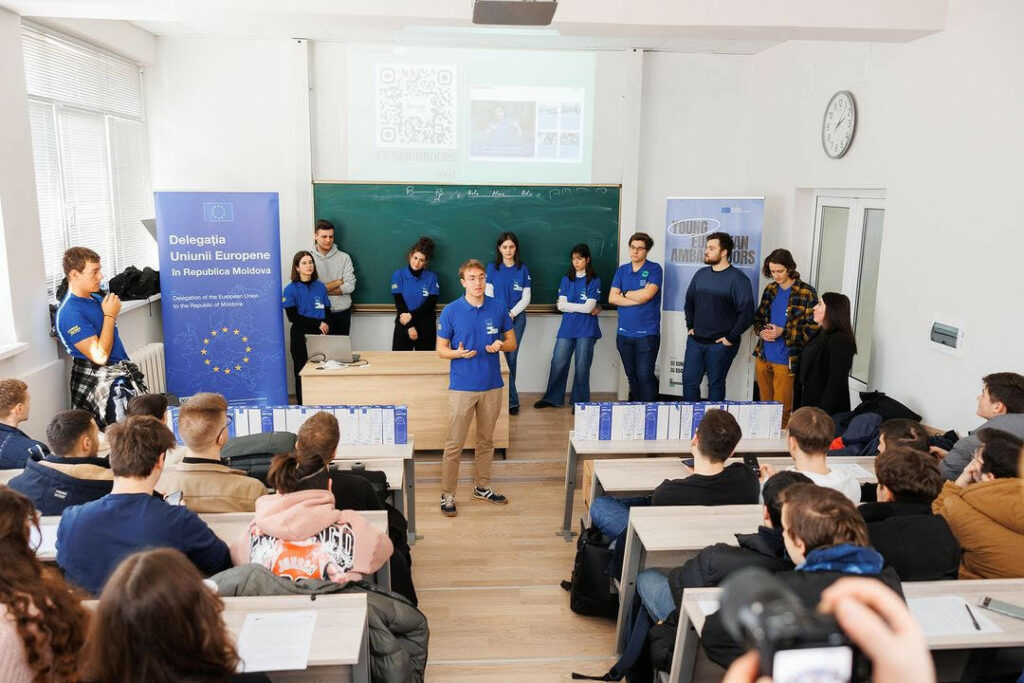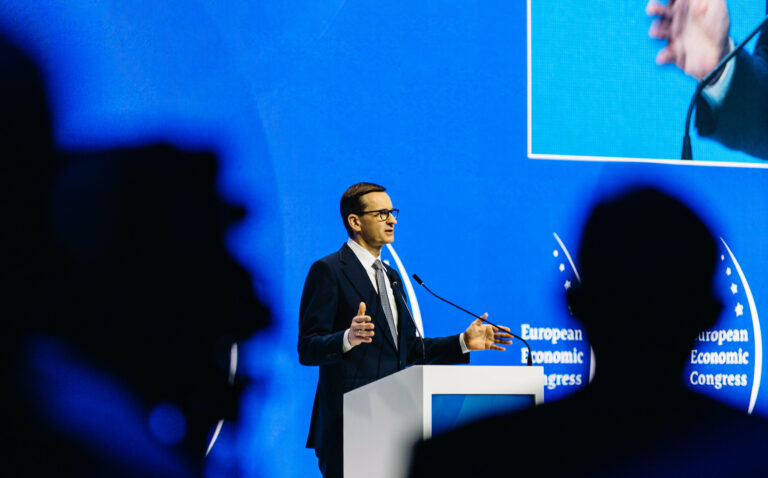
Blog: From Strangers to Neighbours? The development of Moldova’s relationship with the EU
Earlier this year, I had the privilege to be part of a delegation of Young European Ambassadors who travelled to Moldova. For most of us, it was our first time visiting the country, and we were fascinated by its history and culture. We had the chance to talk to a range of young Moldovan citizens, including high school students, undergraduates and business owners, and to learn about their exciting visions for their country’s future. I was particularly eager to learn about Moldova’s transition from a Soviet past to a European future. So, fasten your seatbelts, because, in this blog post, we will zoom in on the development of the EU-Moldova relationship.
One thing I noticed immediately while talking to young people in Moldova is that they know their country’s history incredibly well. Here is a short crash course just so that (unlike me) you can avoid exposing your lack of knowledge.

The Principality of Moldavia was founded during the 1350s and covered the Danube-Dniester area, including parts of modern-day Romania and Ukraine. It was subsequently incorporated into the Ottoman Empire as a vassal state, and throughout the 18th century became the scene of successive military conflicts as the Russian, Austrian and Ottoman empires competed for regional supremacy. Eventually, in 1812, Russia annexed the Eastern Moldavian province of Bessarabia, which constituted nearly half the Principality. In 1856, it returned to southern Bessarabia, allowing the union of the Principalities of Moldavia and Wallachia in 1859, to form the basis of the modern Romanian state. But Russian rule was restored to southern Bessarabia in 1878, as Romania was pressured to exchange these territories for others further south. Following the Russian Revolution of 1917, Bessarabia briefly became independent as the Moldavian Democratic Republic. The new republic’s parliament then voted to reunite with Romania, becoming part of a greater Romania until 1940, when, as a consequence of the Nazi-Soviet pact, Romania was forced to cede Bessarabia to the Soviet Union, where it was incorporated into the Moldavian Soviet Socialist Republic. There it stayed until the dissolution of the USSR when the country declared independence as the Republic of Moldova in 1991.
After declaring independence, the young country needed to create international alliances and gain recognition. A Partnership and Cooperation Agreement (PCA) was signed between the Republic of Moldova and the European Union in November 1994 and came into force four years later.
The agreement provided the basis for political, commercial, economic, legal, cultural and scientific collaborations. To reinforce those provisions and to strengthen Moldova’s integration into the European economy, a three-year action plan within the framework of the EU’s European Neighborhood Policy was implemented in 2005. Five years later came the Association Agreement, which included the creation of a Deep and Comprehensive Free Trade Area, allowing Moldova access to selected sectors of the European market, subject to the same regulatory framework as member states. The Association Agreement further committed both parties to cooperate in a wide range of areas and established a structure for the exchange of information and staff in the judicial sector and the modernisation of Moldova’s energy infrastructure. It also gave Moldova access to the European Investment Bank and enabled ministers, officials and experts to cooperate together through joint summits.
Although these legal frameworks and agreements can seem quite dry and dull, each influences the relationship between EU citizens and nationals of the Republic of Moldova on a day-to-day basis. An example of this is visa liberalisation. In 2014, the EU lifted visa requirements for citizens of Moldova entering the ‘Schengen Zone’ – the border-free area consisting of the 23 EU member states. This liberalisation allows Moldovans to spend up to 90 days in the Schengen area without a visa.

I was able to see some of the fruits of the partnership between the EU and Moldova during our visit to the capital Chișinău and to Cahul, a city in the south. I spoke to many young people at universities and high schools in both cities. Many of them already had first-hand experience of the opportunities provided through Erasmus+, the EU’s programme to support education, training and sport in Europe. In Cahul, I learned about the Cahul Business Incubator, founded through the EU initiative EU4Business, which helps small and medium enterprises to develop their potential. To this day, 22 businesses are supported by the incubator, creating jobs for the area, producing goods, and offering services. However, what struck me most during my visit was the enthusiasm with which young Moldovans look forward to European Union membership. I believe that as EU citizens we can learn from this enthusiasm and take it as an invitation to reflect on the privileges and responsibilities that come with it.
Since the early 2000s, pro-EU Moldovan governments have tried to balance relations with the Russian Federation by closer collaboration with the Union. The EU itself became more interested in Moldova when its eastern enlargement in 2004 made the country a direct neighbour.
With the Russian invasion of Ukraine in 2022, Moldova, together with Georgia and Ukraine, became a focus of the EU enlargement debate. One week after the start of the invasion, President Maia Sandu, together with the President of the Moldovan Parliament, Igor Grosu, and Prime Minister Natalia Gayrilita, signed their country’s application for EU membership. Candidate status was granted to Moldova on the understanding that the country’s fulfilment of its obligations is monitored by the Commission.
My time in Moldova showed me that finding a mutual understanding of Moldova’s prospective position in the EU is crucial. Currently, Moldova is working on implementing the recommendations of the Union in areas such as anti-corruption, ‘de-oligarchisation’, public administration, protection of vulnerable groups and the improvement of the legal system. Although Moldova still has some way to go to become a member of the EU, the relationship between Chișinău and Brussels seems more essential than ever before. Obviously, we cannot ignore the country’s domestic vulnerabilities stemming from fake news campaigns and disputes with Transnistria and Gagauzia, which add a layer of complexity to Moldova’s EU integration path and make it unlikely that progress will always be smooth.
However, these issues also underline the importance of the work that ‘EU Neighbours East’ and the Young European Ambassadors initiative are doing to bring people from the EU and the Eastern Neighbourhood together.
Find out more:
https://euneighbourseast.eu/news/publications/eu-moldova-relations-factsheet/;
https://euneighbourseast.eu/news/explainers/young-european-ambassadors-in-republic-of-moldova/;
https://euneighbourseast.eu/news/explainers/young-european-ambassadors-in-eu/;
https://euneighbourseast.eu/news/latest-news/more-european-union-in-cahul-young-european-ambassadors-meet-local-youth-and-visit-eu-projects-in-moldova/.
LATEST

How you can help the planet every day

Building Europe: Poland’s experience of joining the European Union and lessons for Ukraine

World Health Day 2024: My Health, My Right

EUREKA MEETS EUROPE – opportunities to develop and study. My experience

Can you wear pink in the workplace?
More campaign pages:
Interested in the latest news and opportunities?
This website is managed by the EU-funded Regional Communication Programme for the Eastern Neighbourhood ('EU NEIGHBOURS east’), which complements and supports the communication of the Delegations of the European Union in the Eastern partner countries, and works under the guidance of the European Commission’s Directorate-General for Neighbourhood Policy and Enlargement Negotiations, and the European External Action Service. EU NEIGHBOURS east is implemented by a GOPA PACE-led consortium. It is part of the larger Neighbourhood Communication Programme (2020-2024) for the EU's Eastern and Southern Neighbourhood, which also includes 'EU NEIGHBOURS south’ project that runs the EU Neighbours portal.

The information on this site is subject to a Disclaimer and Protection of personal data. © European Union,